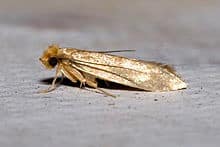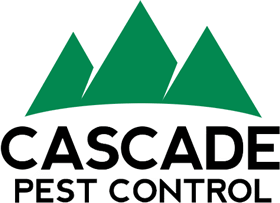Facts About Clothes Moths
Clothes Moths, a species of fungus moth (tineola bisselliella), have narrow wings that are fringed with small hairs and are roughly 1/2” long. Clothes moths are actually rarely seen because they hate light and prefer dark spaces like basements, attics, storage chests, and closets.

Unlike food pantry or kitchen moths, clothes moths feed exclusively on animal fibers or fabrics, such as wool, fur, silk, feathers, leather, and felt. Cotton, rayon, polyester, and synthetic fibers are never typically consumed unless they are blended with an animal fiber, such as wool or silk.
Female clothes moths lay eggs in clusters of between 30 and 200, which hatch between 4 and 10 days later into tiny white caterpillars – which immediately begin to feed. The larvae development into a moth can vary from 1-month to as much as 2-years depending on varying environmental factors.
The caterpillars’ feeding is the damage done to fabrics, clothing, sweaters, upholstery, down pillows, wool rugs, etc. as the adult clothes moths do not feed. The adult clothes moth sole purpose is to find a mate to reproduce. For males, death occurs shortly after mating and for females, shortly after laying their eggs. The overall life cycle typically takes 4–6 months, with two generations per year.
Clothes moths treatment requires a thorough inspection to locate all infested items. Larvae prefer dark areas and heated buildings (in winter), and warmer, hot areas of the house can encourage infestation – even year-round.
CLOTHES MOTHS TREATMENT PREPARATIONS INSTRUCTIONS
Clothes Moths are occasionally encountered in western Washington. They are usually found on woolens such as wall hangings, blankets, area rugs, antique furniture, and garments. Most common is the “case making” clothe moth which will hide inside of lint tubes made from the fibers of the product they are feeding on.
House preparation – must be done before technician arrives
- Wools, Silks and Cashmere items should be drycleaned or at minimum stored in AIRTIGHT storage. Simple garment bags, or plastic bins with lids are not adequate.
- If the bedding is wool remove from the bed and have dry cleaned. Do this first so that you can stack items on the bed if need be
- Clean out all closets (floors, shelves and hanging items) and under beds. Include storage closets, linen closets etc. Throughout the home
- Clothing dressers pull out all clothes, remove empty drawers and stack the drawers facing the same direction. Armoire/wardrobe closet same as above
- Help make baseboards accessible—move small items, toys, etc. (not required to move large furniture.) However, if furniture sits over wool carpet, it may become necessary to move to verify if moths are present in the carpet under the furniture item.
Bathroom/Laundry: you may have wool area carpets or wall hangings your linen closet may be in the bathroom. Empty cabinets including under the sink. Keeping the baseboards and countertops clear, items can be stored in boxes on the floor. Clean Under dryer, dryer vent, under wash machine as lint will build up in these areas and attract carpet beetle.
Vacuum all carpets and baseboard areas, paying attention to baseboard edges as hair and other debris collect here even on tile, vinyl or wood floors. Under the washer and dryer, under beds and other appliances
Post treatment: you may find monitoring traps hanging or placed in various closets and rooms. As discretely as possible. You may begin putting back many of the items you removed to protect the monitors, it is important that air be able to move around them. These devices are to measure they are not for controlling pests on their own. When we return for the follow up, we will use these to indicate areas of persistence. Do not move or double up on the monitors in any one space, this will give false readings.
Discuss with your technician the extent of prep you will need to complete for the follow-up service.
Questions? Call 888-989-8979 for immediate service!
